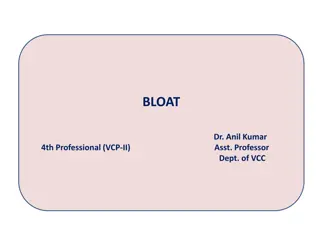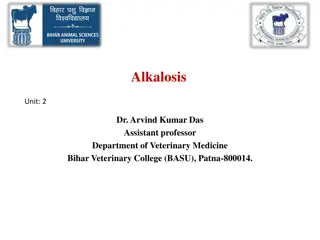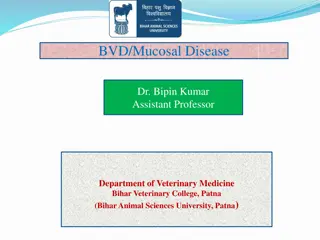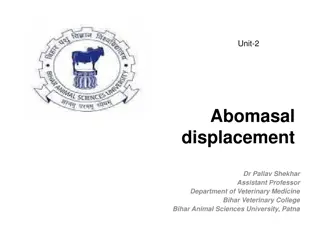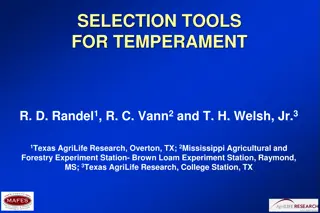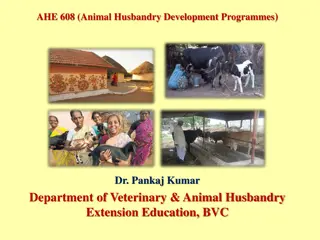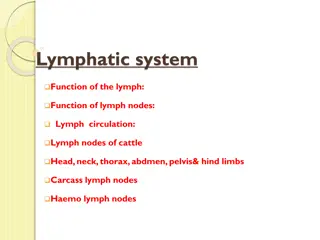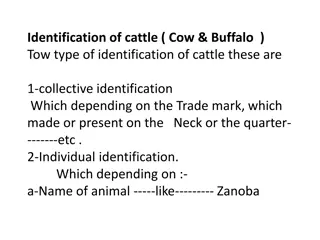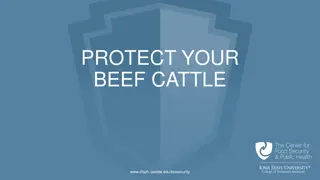Common Infective Diseases in Cattle and Their Implications
Infective diseases such as blackquarter, brucellosis, and foot and mouth disease pose significant threats to cattle health and food safety. Blackquarter is a fatal disease caused by Clostridium chauvaei, while brucellosis leads to contagious abortion in cattle. Foot and mouth disease is highly contagious and affects various animals. Proper hygiene and monitoring are crucial to prevent the spread of these diseases.
Download Presentation

Please find below an Image/Link to download the presentation.
The content on the website is provided AS IS for your information and personal use only. It may not be sold, licensed, or shared on other websites without obtaining consent from the author. Download presentation by click this link. If you encounter any issues during the download, it is possible that the publisher has removed the file from their server.
E N D
Presentation Transcript
Meat Hygiene 3rdand 4thLecture Assistant Prof. Hussein AL-Jiashi
Blackquarter or blackleg Blackquarter is an acute infective disease of cattle and occasionally of sheep and deer, caused by Clostridium chauvaei. It is a soil-borne disease and is therefore more common in animals at pasture. Susceptible animals may be infected by inoculation or more commonly by ingestion of spores. It is most common in young animals up to 2 years old in good bodily condition, and is invariably fatal. In the ox the typical lesion is a swelling that crepitates on pressure. It develops in the subcutaneous tissue and spreads rapidly. Lesions occur most commonly in the large muscles of the fore- and hindquarters, hence the name blackleg or blackquarter. However, many other muscles may be affected, e.g. tongue, masseter muscles, diaphragm and intercostal muscles. On post-mortem examination the connective tissue is infiltrated with a yellow gelatinous substance that is haemorrhagic and gassy. The muscle is blackish-red and oedematous at the periphery of the swelling but dry and sponge-like due to gas spaces in the center. There is a strong smell like rancid butter or cheese. The lymph nodes are enlarged and haemorrhagic. Judgment: Total rejection.
Brucellosis Brucellosis is the collective name for a group of diseases caused by the Brucella species of bacteria. Bovine brucellosis or contagious abortion in cattle is spread mainly by contaminated uterine discharges. Br. abortus can settle in the udder and be excreted in the milk, but it causes no visible lesions in the mammary tissue. In the pregnant uterus, which is the predilection site, the cotyledons are necrotic, soft, yellow-grey in color and covered by a brown exudate. The fetus is usually aborted during the 7th or 8thmonth of pregnancy. The fetus may be oedematous with blood-tinged subcutaneous fluid. Brucellosis is a notifiable disease and testing is done on the farm. If a positive test result is given, the animal is sent for slaughter. This forms part of the eradication program. As brucellosis can be contracted by humans (undulant fever) from Brucella-positive cattle, care should be taken during slaughter that the uterus is not opened and that the udder is removed intact so that spillage of milk does not occur. Malta fever is the similar disease in humans caused by Br. melitensis from goat s milk. Judgment: Reject genital organs and mammary glands.
Foot and mouth disease Foot and mouth disease is the most contagious of all animal diseases. It is caused by a filterable virus of which there are various types. The seven major types are A, O, C, SAT 1, SAT 2, SAT 3 and Asia 1. Cattle, pigs, sheep, goats, deer are susceptible to natural infection. The disease is not endemic in Great Britain but is in other areas of the world such as Asia, Africa, the Middle East and South America. It is introduced into the country mainly in imported frozen meat and possibly as a windborne infection across the Channel from the continent of Europe. Birds may also be implicated. Foot and mouth disease is a notifiable disease and in Britain a slaughter policy is carried out. If foot and mouth disease is suspected in an abattoir, it is imperative that the Divisional Veterinary Manager of DEFRA be notified immediately. There should be no movement in or out of the abattoir until permission is given. Judgment: Total rejection.
Orf (contagious pustular dermatitis or malignant aphtha) Orf is a disease common to sheep and goats and is caused by a virus. Outbreaks of the disease are most common in spring and summer. Sheep of any age may be attacked, but it is prevalent in lambs up to a year old. The disease is characterized by pustular or ulcerative lesions of the skin and mucous membranes, which are often confined to the lips and surrounding tissues, but may affect almost any other part of the body, e.g. feet, skin and genitalia. The disease is communicable to humans, and slaughtermen and meat inspectors are particularly liable to infection because of the skinning of sheep heads and the examination of sheep s tonsils. Judgment: If generalized, the carcass and offal are rejected. Otherwise, local trimming and rejection of affected parts is sufficient.
Tuberculosis Tuberculosis is a chronic infectious disease of humans and animals caused by Mycobacterium tuberculosis. There are three common types of the tubercle bacillus: (1) The human type M. tuberculosis. (2) The bovine type M. bovis. (3) The avian type M. avium. There is a fourth type that affects fish. (1) Human type. This affects humans, but can also affect cattle and pigs to a much lesser extent. Its only importance in animals is that it causes reaction to the tuberculin test in cattle. (2) Bovine type. This affects humans, cattle, deer and pigs. It is much the most virulent type for cattle and pigs. Bovine tuberculosis in deer has occurred mainly in farmed animals in association with imported deer. One outbreak occurred in a wild herd of sika deer in Dorset in an area in which there is a history of bovine tuberculosis in cattle.
(3) Avian type. This affects birds, pigs, deer and, to a much lesser extent, cattle. Avian tuberculosis in pigs, as well as being caused by M. avium, may also be caused by M. intracellularae, which is found in wood shavings and sawdust. Wild deer are particularly susceptible to the avian type. Pathogenesis of tuberculosis Tubercle bacilli when they enter the body produce a primary lesion generally in the respiratory or digestive tract. Following this, lesions appear in the associated lymph nodes. The primary lesion may be difficult to find, especially in the intestine. In the lungs the lesion is usually in the substance of the lung at the termination of a bronchiole. The body tissues generally have specific reactions to different bacilli. In the case of tubercle bacilli, phagocytic cells proliferate around the multiplying bacilli, resulting in the formation of a nodule or tubercle . Multinucleated giant cells also appear and the lesion increases in size owing to the destruction of the normal tissue and the fusion of adjacent tubercles.
The lesions are microscopic to begin with and are normally only visible to the naked eye after about 3 weeks. They have a translucent greyish appearance at first and this is best seen in miliary tuberculosis of the lung. The lesions then become necrotic and opaque or yellowish-white in appearance. Necrosis is followed by caseation in which the necrotic tissue becomes cheesy in texture. Sometimes fibrous tissue forms at the periphery of the lesion forming a capsule, limiting the local spread of the disease process. Calcification may then follow. If the animal does not die from the acute miliary type, the condition may become chronic, in which case the disease involves the pleura and peritoneum ( grapes ) and various organs in which the lesions are of a caseous or calcified nature owing to the deposition of calcium. The body defenses may be adequate and the disease becomes quiescent or healing takes place. Reinfection or breakdown can occur when the body is weakened in some way, e.g. by starvation or pregnancy. Judgment: If generalized or associated with emaciation, total rejection. If localized, reject affected parts.
Meat Preservation and Meat Products: Unless meat is preserved in some way it soon putrefies. This is due to the action of bacteria, molds and yeasts. These obtain nourishment from the meat and in so doing alter it in various ways. To grow and proliferate the organisms need temperatures favorable to them. It is therefore customary to classify organisms as follows: (1) Psychrophiles, which have an optimum temperature range of -2 to 7 C. (2) Mesophiles, which have an optimum temperature range of 10 to 40 C. (3) Thermophiles, which have an optimum temperature range of 43 to 66 C. It is thus possible to preserve meat by subjecting it to temperatures approximating to: (1) -2 C (sub-optimal temperatures) by chilling or freezing. (2) 66 C (super-optimal temperatures) by pasteurizing, cooking or sterilizing.
Organisms also need water for growth and so it is possible to preserve meat by removing this by dehydration, freezing or curing. Some bacteria, e.g. Clostridium perfringens, liquefy the connective tissue in meat, causing it to disintegrate. Gases such as hydrogen sulphide, carbon dioxide, ammonia and indole are produced. The glycogen or muscle sugar is fermented, giving rise to acetic or butyric acids, which cause offensive smells and tastes. Discoloration is caused by changes in the myoglobin or muscle pigment. Brown, green and yellow colors appear when the myoglobin is acted upon by oxygen, hydrogen sulphide and hydrogen peroxide, which are produced by the bacteria present. Discoloration may also be due to pigments produced by various organisms, e.g. Pseudomonas, Serratia marcescens, micrococci and yeasts give rise to greens, reds and pinks. Molds also produce pigments, e.g. Cladosporium, Sporotrichum and Penicillium give black, white and bluish-green colors, respectively.
Preservation by cold Meats can be preserved by chilling and freezing. This is the simplest and easiest method of preservation and is the basis of refrigeration. By refrigeration, meat can be kept for long periods with relatively little deterioration in appearance, texture and flavor. Preservation by cold or refrigeration depends on the fact that bacteria are unable to multiply at low temperatures, mainly due to the fact that water, which is necessary for this, is changed to ice. Another factor is that most of the harmful bacteria grow best at body temperature (37 C). It is very important to remember that bacteria are resistant to cold but are not killed by it. Live bacteria have been found in ice core samples that came from over 140 meters deep in the Antarctic. The bacteria may be at least 10000 years old. When the temperature rises and the meat thaws out, the bacteria start to multiply and may cause the formation of surface slime . Three conditions are necessary for this formation: (1) contamination, (2) temperature at which bacteria can grow, i.e. above freezing, and (3) moisture, which allows the contamination to spread, e.g. sweating on chilled and frozen beef.
Chilling of meat: This method is useful when meat has to be preserved for a relatively short time, up to 35 days. Chilled meat loses very little in appearance, nutritive value and taste. It is kept at between -1.4 C (meat freezes at - 1.4 C) and 1 C, preferably in the dark as light has the effect of oxidizing fats. Light liberates free fatty acids and the fat becomes rancid. The atmosphere should be kept dry to prevent mold formation, for which moisture is necessary. A concentration of 5 10% carbon dioxide helps to prevent the growth of molds and bacteria. After slaughter most carcasses are chilled in chill rooms in which cold air is circulated, bringing the temperature down to -1 C. It is important that the temperature does not reach -1.4 C, otherwise the meat will freeze. If the chilling process is too rapid, cold shortening occurs, which is an undesirable feature.
Cold shortening Toughness develops in lamb carcasses, particularly if they are exposed to low temperatures within about 16 hours after slaughter. This is due to cold shortening of the muscles. While the pH is about 6.3 and the ATP levels are high, lowering of the temperature causes the muscles to contract. It normally starts at 15 C and becomes greater down to 0 C. This causes toughness of meat on cooking. Beef carcasses do not chill as quickly as lamb carcasses because of the thickness of the muscles. However, the superficial layers may be affected. Cold shortening is not a problem in pig carcasses because the pH falls more rapidly than in the other animals. Also the pig s skin and the subcutaneous fat protect the underlying muscles from the rapid cooling. Therefore, pig carcasses can be cooled more rapidly. Good chilling practices are probably the most important factors in the keeping quality of meat: (1) Carcasses should not touch each other. (2) Hot carcasses should not be mixed with cold carcasses. (3) Chill-room doors should be kept closed as much as possible. (4) The chill-room should not be overloaded.
(5) Chill-room temperature should be checked regularly. (6) Excessive condensation should be avoided to prevent frost forming on chill-room equipment. Chilled carcasses require an adequate supply of air around them and so have to be hung on hooks, which is rather space consuming. Frozen carcasses, however, can be stacked and therefore require less space. Freezing of meat Temperatures in ordinary freezing vary between -1 and -5 C. Frozen meat can be kept for a long time. Frozen beef has a storage life of about 12 months, veal slightly less, mutton and lamb about 8 months and pork about 6 months without too much deterioration. Frozen meat stored too long becomes dry, less palatable and rancid. After thawing it is less durable than fresh-killed or chilled meat. When frozen meat is thawed it weeps or drips. A watery blood-stained fluid called drip escapes. This consists mainly of water, salt, extractives, protein and damaged blood corpuscles. Weeping or drip is an undesirable feature and is caused mainly by the rupture of the muscle cells by large crystals of ice.
The loss of weight due to drip in beef is up to 3%. The loss is greater in beef than in mutton, lamb or pork. Freezing of meat constitutes a change of state because an irreversible change takes place in the sarcoplasm or muscle protein at -2 C (remember that meat freezes at - 1.4 C). Muscle and fat are poor conductors of heat and during slow freezing a large proportion of the fluid in the muscle cells passes through the cell walls and collects between the muscle fibers. There it freezes into ice crystals. The slower the freezing process the larger the ice crystals become and because of their size more damage is done to the meat. On thawing, these extracellular ice crystals produce fluid, some of which is not reabsorbed. This produces drip. If, however, freezing takes place very quickly, the ice crystals are very small and are formed within the cells. Less damage is done to the meat and on thawing less drip is produced. One method of quicker freezing is called blast freezing, in which cold air is blown onto the meat. The ice crystals reach their maximum size at between -1 and -4 C, called the zone of maximum ice crystal formation .
After initial freezing it is therefore important to store meat below -4C. The extent of drip is determined by various factors: (1) Amount of damage caused to the muscles by freezing and cold storing. (2) Size and shape of the meat. This includes the ratio of cut surface to volume and directions of cuts in relation to the axis of the muscle fibers. These factors are more important in beef than in mutton or pork as more cutting is required to produce the right size. If muscle is frozen before rigor mortis sets in, there is marked contraction on thawing ( thaw rigor ) and excessive drip unless the muscle is held taut, e.g. as in a whole carcass of lamb. This is important because of the newer methods of freezing lamb carcasses. These are blast-frozen straight from the slaughter line, when warm and before rigor mortis occurs.
Freezer burn: This is the name given to yellowish-brown or whitish areas seen on the surface of frozen meats. It is due to excessive drying of the surface and can be caused when unprotected meat is blast-frozen or when meat comes into close contact with refrigeration pipes or is placed too close to cold air inlets. The phenomenon involves the formation of a condensed layer of muscular tissue just under the surface. This prevents moisture coming to the surface from the depth of the meat. Excessive surface drying then follows. Judgment: Local trimming is all that is necessary.


